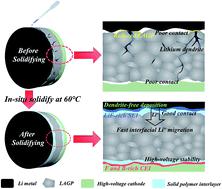当前位置:
X-MOL 学术
›
J. Mater. Chem. A
›
论文详情
Our official English website, www.x-mol.net, welcomes your
feedback! (Note: you will need to create a separate account there.)
An in situ solidifying strategy enabling high-voltage all-solid-state Li-metal batteries operating at room temperature
Journal of Materials Chemistry A ( IF 10.7 ) Pub Date : 2020-11-12 , DOI: 10.1039/d0ta08590a Zhu Cheng 1, 2, 3, 4, 5 , Hui Pan 1, 2, 3, 4, 5 , Chao Li 1, 2, 3, 4, 5 , Xiaowei Mu 1, 2, 3, 4, 5 , Yueming Du 1, 2, 3, 4, 5 , Fan Zhang 1, 2, 3, 4, 5 , Xueping Zhang 1, 2, 3, 4, 5 , Ping He 1, 2, 3, 4, 5 , Haoshen Zhou 1, 2, 3, 4, 5
Journal of Materials Chemistry A ( IF 10.7 ) Pub Date : 2020-11-12 , DOI: 10.1039/d0ta08590a Zhu Cheng 1, 2, 3, 4, 5 , Hui Pan 1, 2, 3, 4, 5 , Chao Li 1, 2, 3, 4, 5 , Xiaowei Mu 1, 2, 3, 4, 5 , Yueming Du 1, 2, 3, 4, 5 , Fan Zhang 1, 2, 3, 4, 5 , Xueping Zhang 1, 2, 3, 4, 5 , Ping He 1, 2, 3, 4, 5 , Haoshen Zhou 1, 2, 3, 4, 5
Affiliation

|
At present most reported all-solid-state Li-metal batteries (ASSLBs) have to operate at elevated temperature due to the huge resistances at solid–solid interfaces. Also, the poor stability of solid-state electrolytes (SSEs) against both Li metal and high-voltage cathodes largely restricts the development of high-voltage ASSLBs featuring high energy density. Herein, a succinonitrile-based solid polymer interlayer (SPI) is in situ introduced at the Li1.5Al0.5Ge1.5(PO4)3 (LAGP)–Li and LAGP–cathode interfaces. The SPI perfectly fills all cracks and voids at solid–solid interfaces, and exhibits high ionic conductivity and a wide electrochemical window up to 4.8 V, which not only provides fast interfacial lithium-ion transport, but also significantly improves the interfacial stability of the SSEs against both Li metal and high-voltage layered oxide cathodes. Therefore, the SPI-based symmetric cell shows stable cycling at 0.1 mA cm−2 for 600 h and a high critical current density of 7 mA cm−2. The LiNi0.8Co0.15Al0.05O2–SPI–LAGP–SPI–Li cell shows a high capacity of 200 mA h g−1 at 0.1C and stable cycling after 100 cycles at 0.5C with a capacity retention of 80% at room temperature. This work presents an effective and practical strategy to achieve outstanding performance of room-temperature ASSLBs with high output voltage.
中文翻译:

原位固化策略使高压全固态锂金属电池在室温下工作
目前,大多数报告的全固态锂金属电池(ASSLB)必须在高温下工作,这是因为固态/固态界面处的电阻很大。同样,固态电解质(SSE)对锂金属和高压阴极的不良稳定性极大地限制了具有高能量密度的高压ASSLB的发展。在此,在Li 1.5 Al 0.5 Ge 1.5(PO 4)3上原位引入基于丁二腈的固体聚合物中间层(SPI)。(LAGP)–Li和LAGP–阴极接口。SPI完美填充了固-固界面上的所有裂缝和空隙,并具有高离子电导率和高达4.8 V的宽电化学窗口,这不仅提供了快速的锂离子界面迁移,而且还显着提高了SSE的界面稳定性锂金属和高压层状氧化物阴极。因此,在0.1mA厘米基于SPI-对称细胞显示稳定的循环-2为600小时,的7毫安cm的高临界电流密度-2。LiNi 0.8 Co 0.15 Al 0.05 O 2 –SPI–LAGP–SPI–Li电池显示200 mA hg -1的高容量在0.1C的温度下保持稳定,在0.5C的温度下循环100次后稳定循环,在室温下保持80%的容量。这项工作提出了一种有效且实用的策略,以实现具有高输出电压的室温ASSLB的出色性能。
更新日期:2020-11-23
中文翻译:

原位固化策略使高压全固态锂金属电池在室温下工作
目前,大多数报告的全固态锂金属电池(ASSLB)必须在高温下工作,这是因为固态/固态界面处的电阻很大。同样,固态电解质(SSE)对锂金属和高压阴极的不良稳定性极大地限制了具有高能量密度的高压ASSLB的发展。在此,在Li 1.5 Al 0.5 Ge 1.5(PO 4)3上原位引入基于丁二腈的固体聚合物中间层(SPI)。(LAGP)–Li和LAGP–阴极接口。SPI完美填充了固-固界面上的所有裂缝和空隙,并具有高离子电导率和高达4.8 V的宽电化学窗口,这不仅提供了快速的锂离子界面迁移,而且还显着提高了SSE的界面稳定性锂金属和高压层状氧化物阴极。因此,在0.1mA厘米基于SPI-对称细胞显示稳定的循环-2为600小时,的7毫安cm的高临界电流密度-2。LiNi 0.8 Co 0.15 Al 0.05 O 2 –SPI–LAGP–SPI–Li电池显示200 mA hg -1的高容量在0.1C的温度下保持稳定,在0.5C的温度下循环100次后稳定循环,在室温下保持80%的容量。这项工作提出了一种有效且实用的策略,以实现具有高输出电压的室温ASSLB的出色性能。











































 京公网安备 11010802027423号
京公网安备 11010802027423号